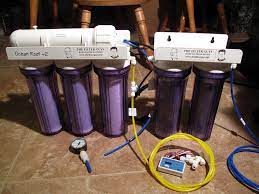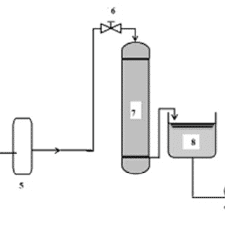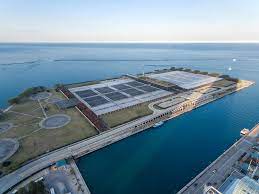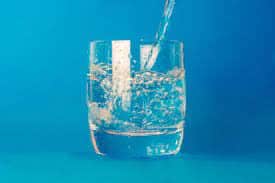HOW TO PURIFY WATER IN THE UK

Tap water in the UK is typically purified through a multi-step process involving various techniques and equipment. While reverse osmosis (RO) is not the primary method used for tap water purification in the UK, it is occasionally employed in specific cases where the water source or quality requires additional treatment. Let’s delve into how tap water in the UK can be purified using reverse osmosis and explore the variations in its implementation.
Reverse osmosis is a water purification process that utilizes a semi-permeable membrane to remove impurities and contaminants from water. In the context of tap water purification, reverse osmosis can be implemented as an advanced treatment step to enhance the quality of the water.

The process of reverse osmosis involves several key components:
- Pre-treatment: Before the water enters the reverse osmosis system, it undergoes pre-treatment to remove larger particles and impurities. This can involve processes such as sediment filtration, activated carbon filtration, and sometimes even water softening to reduce water hardness.
- Reverse Osmosis Membrane: The heart of the reverse osmosis system is the semi-permeable membrane. This membrane has extremely tiny pores that allow water molecules to pass through while blocking larger molecules and contaminants. When the water is forced through the membrane under pressure, impurities such as dissolved salts, minerals, chemicals, bacteria, viruses, and some larger particles are rejected and flushed away as waste.
- Pressure and Energy: Reverse osmosis requires pressure to overcome the natural osmotic pressure and drive the water through the membrane. To achieve this, a pump is used to pressurize the feed water, allowing it to pass through the membrane. This process consumes energy, typically supplied by an electric motor.
- Permeate and Reject Streams: The water passing through the membrane is separated into two streams. The purified water that successfully crosses the membrane is known as permeate, while the impurities and rejected substances are diverted to the drain as the reject stream.
Variations in Reverse Osmosis Implementation:
- Point-of-Use Reverse Osmosis: Point-of-use (POU) reverse osmosis systems are installed at specific tap points, such as under the sink, to treat water for drinking and cooking purposes. These systems typically consist of a small RO unit with its own faucet, storage tank, and post-treatment filters. POU reverse osmosis can effectively remove a wide range of contaminants, including dissolved minerals, heavy metals, pesticides, and organic compounds.
- Brackish Water Reverse Osmosis: Brackish water reverse osmosis is utilized when the source water has a moderate to high level of salinity or total dissolved solids (TDS). This process is designed to treat water with a lower salt concentration compared to seawater desalination. It involves a more robust reverse osmosis system with specialized membranes capable of handling higher salt levels.
- Seawater Reverse Osmosis: Seawater reverse osmosis (SWRO) is employed in coastal areas where the source water is seawater. This process is specifically designed to desalinate seawater and remove the high concentration of salts and minerals. SWRO systems are typically larger and more energy-intensive compared to brackish water or tap water RO systems due to the higher pressure requirements and the need to overcome the elevated osmotic pressure of seawater.
- 4 Industry specific reverse Osmosis is used to remove the last of the minerals from water, such as when considering how to purify water for window cleaning a filtration system is used that includes generally a carbon and a sediment filter. Often a “finisher” is also used, which is a bottle of resin that captures the now very low PPM of minerals and turns it into 0 PPM water. This is how we operate as window cleaners in Fife
It is important to note that while reverse osmosis is effective in removing a wide range of impurities, it is not without limitations. Some contaminants, such as certain volatile organic compounds (VOCs), gases, and very small particles, may not be effectively removed by the RO membrane alone. Therefore, additional treatment processes, such as activated carbon filtration or disinfection, are often employed as mentioned for window cleaning and other industry.

DEIONIZED WATER
In the United Kingdom, deionized water, also known as demineralized water or DI water, plays a crucial role in various industries and applications and how to filter water. Unlike reverse osmosis (RO) water, which is not the focus of this discussion, deionized water is produced through a distinct process that removes all ions, including minerals and salts, from the water. Let’s explore the purpose, use, and significance of deionized water in the UK.
Deionized water is created by passing raw water through ion exchange resins or membranes that selectively attract and remove ions. The process eliminates both cations (positively charged ions) and anions (negatively charged ions), resulting in water that is extremely pure and free of any dissolved substances.
The purpose of producing deionized water is primarily to obtain a water source that is devoid of impurities, minerals, and contaminants. The absence of ions in deionized water makes it highly useful in industries and applications where the presence of minerals or other impurities can interfere with processes or cause undesirable effects.
Here are some key uses and applications of deionized water in the UK:
- Laboratories and Scientific Research: Deionized water is a vital resource in laboratories and scientific research facilities. It is used in various analytical techniques, such as spectroscopy, chromatography, and titration, where the presence of impurities or ions can affect the accuracy and reliability of results. Deionized water ensures that the purity of the water does not introduce any unwanted variables into the experiments.
- Medical and Pharmaceutical Applications: Deionized water finds extensive use in medical and pharmaceutical industries. It is a critical component in the preparation of medicines, injections, and intravenous solutions. Deionized water is also employed in the manufacturing of medical devices, as well as in cleaning and sterilization processes to ensure the absence of impurities.
- Electronics and Semiconductor Manufacturing: Deionized water plays a vital role in the electronics and semiconductor industries. It is used in various stages of electronic component manufacturing, including cleaning, rinsing, and etching processes. Deionized water’s high purity prevents mineral deposits or impurities from interfering with the delicate electronic components, ensuring their functionality and reliability.
- Power Generation: Deionized water is employed in power generation facilities, particularly in steam power plants and nuclear power plants. It is used in the production of steam, which drives turbines to generate electricity. Deionized water’s purity prevents mineral deposits or impurities from accumulating in the boilers or cooling systems, thus maintaining their efficiency and preventing corrosion.
- Automotive and Aerospace Industries: Deionized water is utilized in the automotive and aerospace sectors for various applications. It is commonly employed in cooling systems, parts cleaning, battery manufacturing, and as a coolant or lubricant in machining processes. Deionized water’s purity ensures that no residue or impurities are left behind, contributing to the quality and longevity of the manufactured products.
- Cosmetics and Personal Care Products: Deionized water is a key ingredient in the formulation of cosmetics and personal care products. Its purity ensures that these products are free from contaminants that could potentially harm the skin or compromise the effectiveness of the formulation. Deionized water is used in shampoos, lotions, creams, and other beauty and personal care items.
The significance of deionized water lies in its ability to provide a highly pure water source that is free from impurities, minerals, and contaminants. Its use in various industries and applications ensures the reliability, quality, and safety of processes, products, and experiments.
In conclusion, deionized water plays a critical role in the UK across a wide range of industries and applications. Its high purity, achieved by removing all ions and impurities, makes it an essential resource
COMPARE
Reverse osmosis (RO) water filtration systems is capable of removing impurities at the parts per billion (ppb) level. The semi-permeable membrane used in RO systems has extremely small pores that can effectively filter out ions, molecules, and contaminants, including those present at very low concentrations. As a result, RO water typically has a significantly reduced concentration of impurities, including those measured in ppb.
Deionized (DI) water, on the other hand, primarily focuses on the removal of ions, which are typically measured in parts per million (ppm). DI water purification systems use ion exchange resins or membranes to remove cations and anions, resulting in water with a significantly reduced ion concentration, often measured in ppm.
It is important to note that the effectiveness of both RO and DI systems in removing specific impurities can vary depending on the quality of the feed water, the design and condition of the filtration system, and the specific contaminants being targeted. Regular maintenance, system monitoring, and periodic water quality testing are essential to ensure optimal performance and confirm the removal of impurities at the desired levels.
WHAT IS TDS
Total Dissolved Solids (TDS) and Parts Per Million (PPM) are measurements used to quantify the concentration of dissolved substances in water. TDS refers to the total amount of inorganic and organic substances present in a liquid solution, including minerals, salts, metals, ions, and other dissolved solids. PPM is a unit of measurement that expresses the concentration of these dissolved solids in water.
The measurement of TDS and PPM is based on the principle of electrical conductivity. When dissolved solids are present in water, they increase its ability to conduct electrical current. A TDS meter or conductivity meter is used to measure the electrical conductivity of the water sample, which is then converted into TDS or PPM values.
TDS and PPM measurements are commonly used in various industries and applications. In the field of water quality, they provide insights into the overall purity or contamination levels of water. Higher TDS or PPM values indicate a greater concentration of dissolved solids, which can affect the taste, odor, and quality of water.
It’s important to note that not all dissolved solids are harmful or undesirable. In fact, many minerals and salts contribute to the essential characteristics of drinking water. However, excessively high levels of certain dissolved solids, such as heavy metals or pollutants, may pose health risks and affect water quality.
TDS and PPM measurements are often used as indicators to determine the effectiveness of water treatment processes, such as filtration or purification systems. By comparing TDS or PPM values before and after treatment, it is possible to assess the efficiency of the treatment method in reducing dissolved solids and improving water quality.
In summary, TDS and PPM measurements provide valuable information about the concentration of dissolved solids in water. They serve as indicators for water quality and help in monitoring the effectiveness of water treatment processes. Regular testing and monitoring of TDS and PPM levels can aid in maintaining safe and desirable water quality for various applications.
DRINKING PURIFIED REVERSE OSMOSIS OR DEIONIZED WATER
Systems can remove a wide range of contaminants, including dissolved solids, minerals, heavy metals, bacteria, and viruses. While this makes the water clean and safe to drink, it may also result in the removal of beneficial minerals like calcium, magnesium, and potassium. These minerals play important roles in maintaining good health. However, it’s important to note that most of our daily mineral intake comes from food, so the impact of mineral loss from drinking RO water alone is generally minimal.
DIFFERENCE BETWEEN DISTILLED AND DI WATER
There are different types of water in the uk such as distilled Water: Distilled water is produced through the process of distillation, which involves vaporizing water and then condensing the steam back into liquid form. Distillation effectively removes impurities, including minerals, contaminants, and most dissolved solids. As a result, distilled water has an extremely low concentration of impurities, approaching pure H2O. It is free from minerals, ions, and most organic compounds.
Deionized (DI) Water: DI water is created by passing water through ion exchange resins or membranes, which remove ions and charged particles from the water. DI water goes through a deionization process to eliminate cations (positively charged ions) and anions (negatively charged ions), resulting in water that is highly purified. However, DI water may still contain certain non-ionic impurities.
In terms of chemical composition, both distilled water and DI water are primarily composed of H2O molecules. However, due to the absence of minerals and ions, DI water may have a slightly higher electrical conductivity compared to distilled water. Distilled water has a neutral pH, typically around 7, while the pH of DI water can vary depending on the specific purification process and any subsequent treatment it may undergo.
HOW TO MAKE A WATER FILTER IN THE HOME
Making a water filter for home use requires a few basic materials and can be done using a simple DIY approach. Here’s a general outline:
- Gather the materials: You’ll need a clean plastic or glass container, activated carbon or charcoal, fine sand, gravel, and a coffee filter or cloth.
- Prepare the container: Clean the container thoroughly to ensure it is free from any contaminants.
- Layer the filter media: Begin by adding a layer of gravel at the bottom, followed by a layer of fine sand on top. Place the activated carbon or charcoal on the sand layer.
- Add the water: Slowly pour the water to be filtered through the layers of the filter media. The gravel, sand, and activated carbon will work together to trap impurities and improve water quality.
- Collect the filtered water: Allow the water to pass through the filter and collect it in a separate container placed beneath.
While homemade water filters can offer some level of filtration, it’s important to note that they may not be as effective as commercially available filters. For thorough purification and removal of specific contaminants, consider investing in a reliable, certified water filtration system suitable for your needs.
WHAT DOES A HOME WATER FILTER DO
Water filters used in homes are designed to remove various impurities and contaminants, improving the quality and taste of the water. Common water filters can effectively remove sediment, chlorine, volatile organic compounds (VOCs), heavy metals like lead and mercury, pesticides, herbicides, and other chemical pollutants. Some advanced filtration systems, such as reverse osmosis (RO) or activated carbon filters, can also reduce dissolved solids, bacteria, viruses, and pharmaceutical residues. The specific contaminants removed by a water filter depend on the type of filter and its filtration technology. Regular maintenance and filter replacements are essential to ensure the continued effectiveness of the water filter system.
HOW DOES A WATER FILTER WORK
A water filter used at home works by employing various filtration mechanisms to remove impurities and contaminants from the water. The exact working principle depends on the type of filter being used. Common home water filters, such as activated carbon filters, work by trapping and adsorbing impurities through the porous structure of the carbon. This process effectively removes chlorine, volatile organic compounds (VOCs), and some chemical pollutants. Other filters, like reverse osmosis (RO) systems, use a semi-permeable membrane to separate impurities from the water. The water passes through the membrane, while contaminants are trapped and flushed away. The result is cleaner, better-tasting water for household use.




